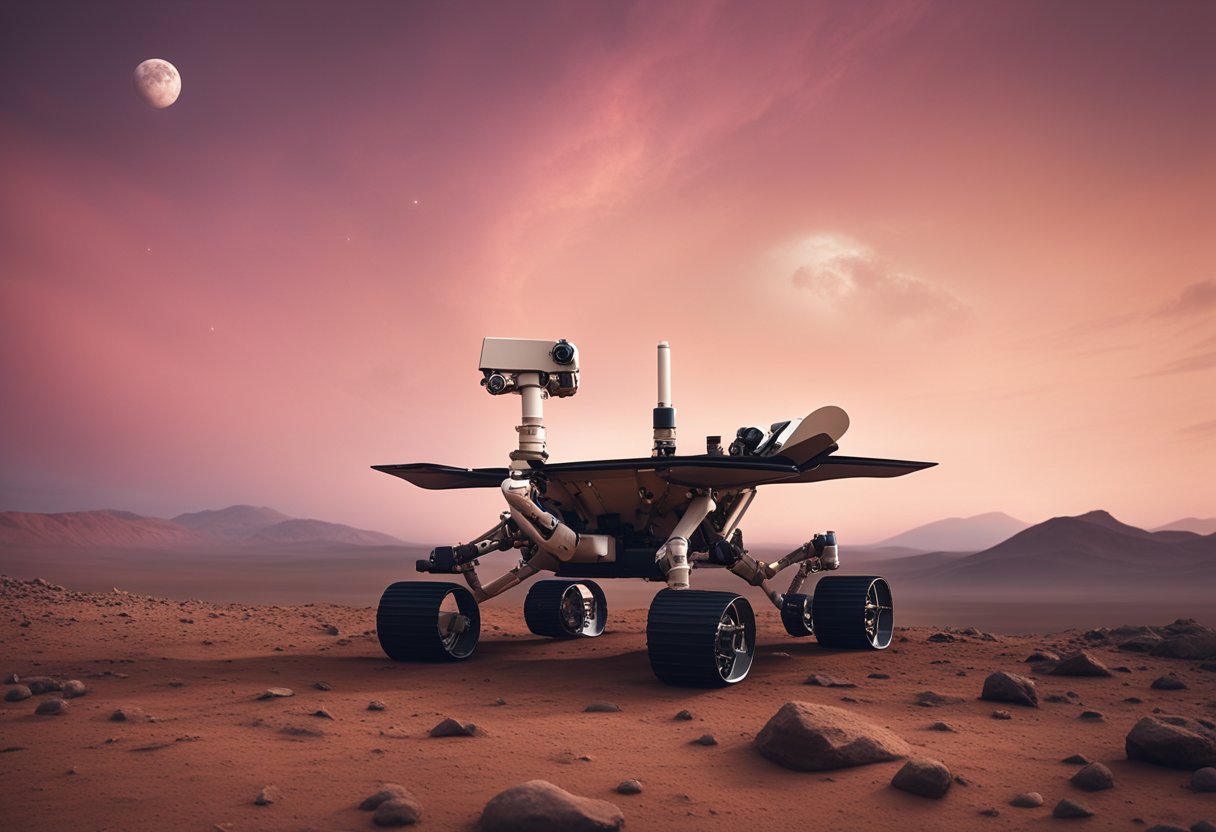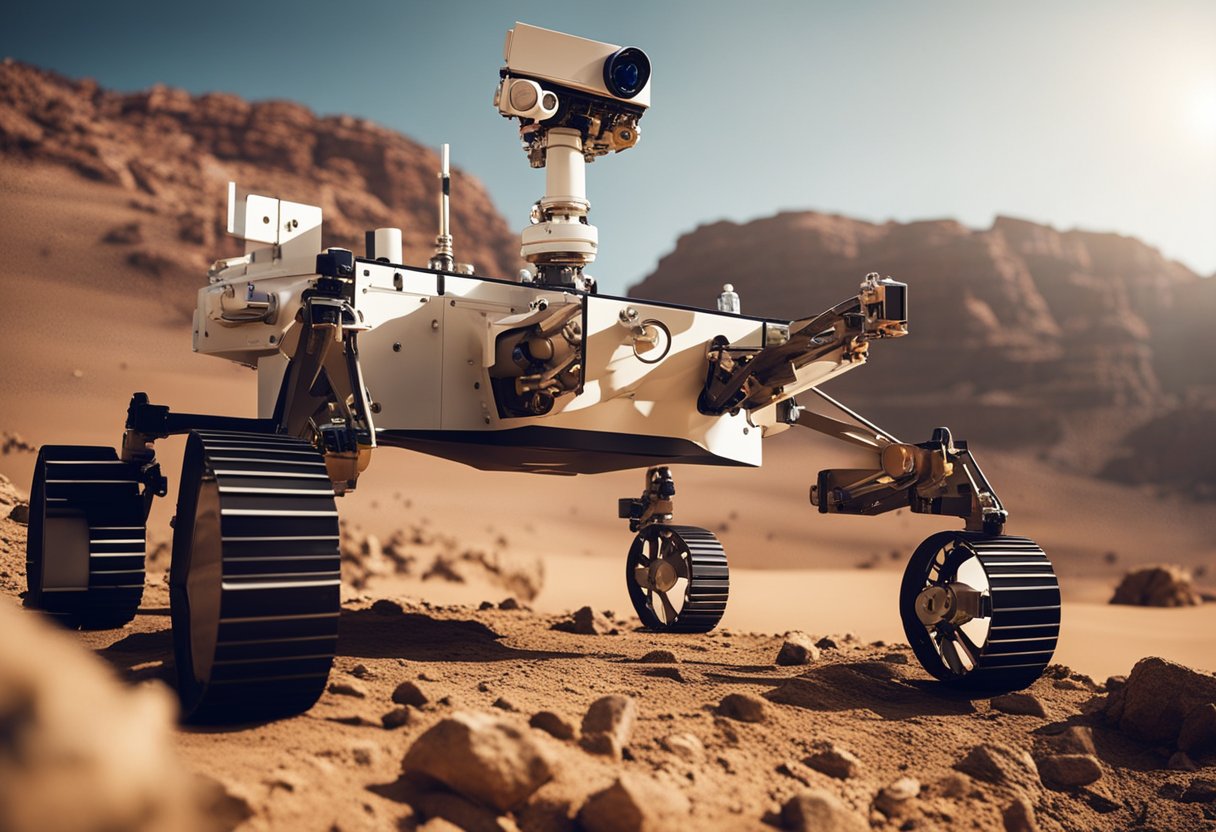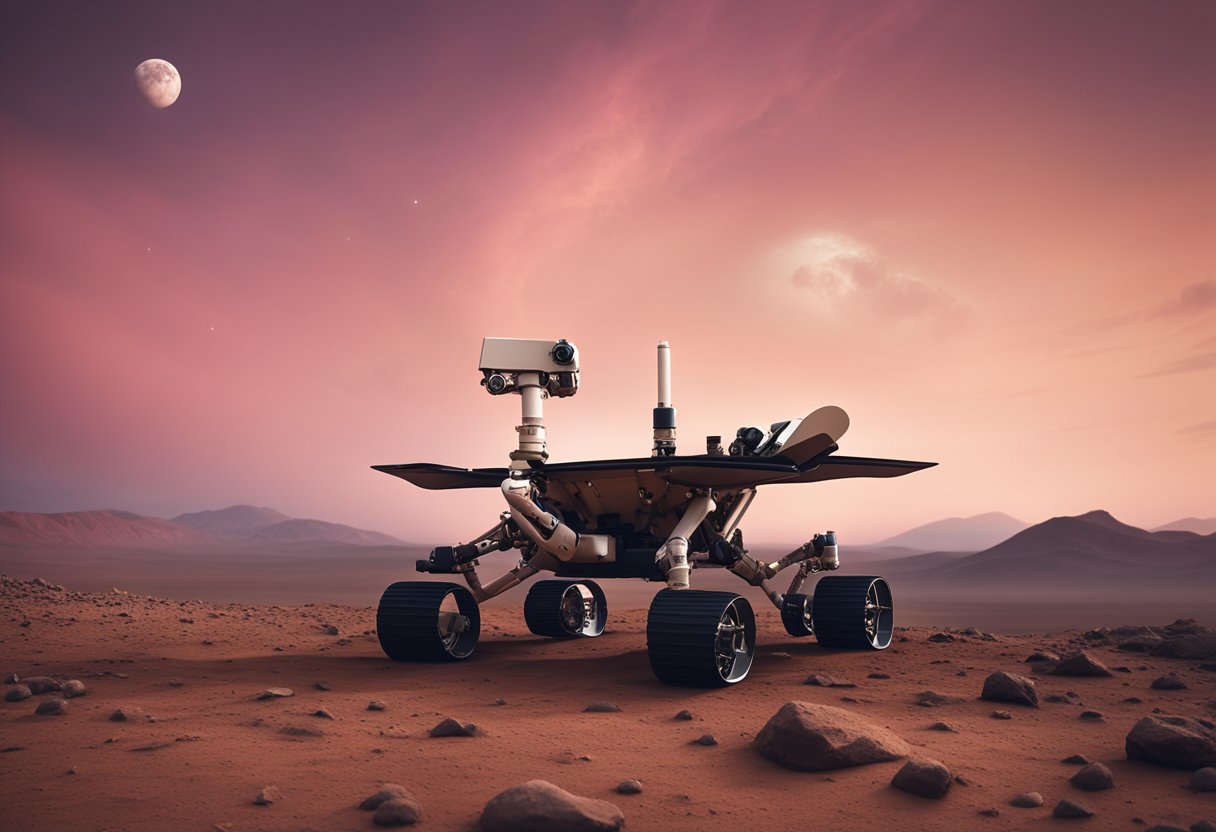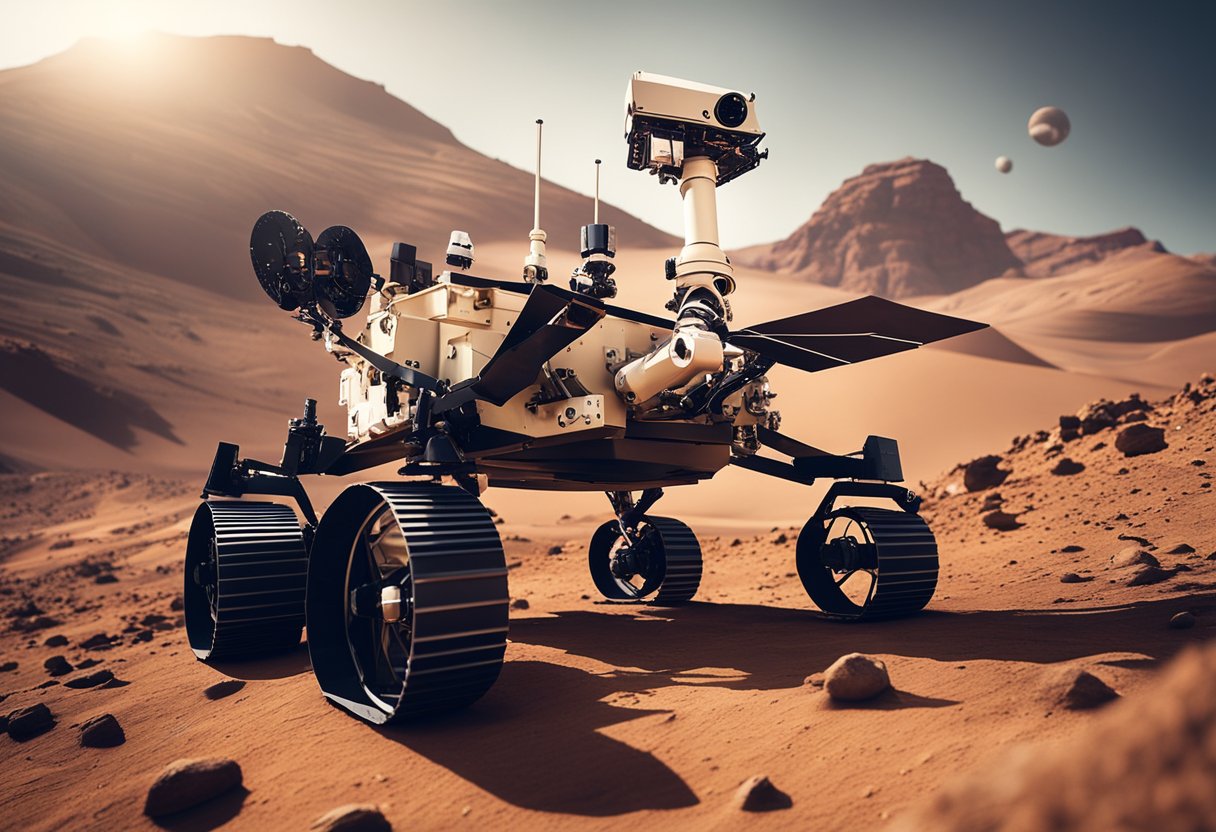
Mars rover missions represent one of the most inspiring and challenging undertakings in space exploration. These sophisticated robots serve as our emissaries, travelling to the Martian surface to uncover its secrets. As we extend our reach beyond Earth, Mars serves as a crucial step in our cosmic journey. The rovers we send are equipped to traverse varied terrain, analyse geological formations, and search for signs of past life, helping us to better understand the planet’s history and environment.

Rovers like the Mars Exploration Rovers Spirit and Opportunity, as well as the more recent Perseverance rover, have already made significant strides in expanding our knowledge of Martian geology and potential for life. These missions have not only demonstrated the resilience of human ingenuity but have also laid the foundations for the next generation of exploration. They’ve examined landing sites, probed the Martian climate and atmosphere, and tested technologies critical for future missions. With each launch, we reaffirm our commitment to unravelling the mysteries of our neighbour in the solar system.
The study of Mars has expanded dramatically with numerous rover missions deployed by agencies including NASA and ESA. These rovers play a pivotal role in unveiling Mars‘ secrets and paving the way for future exploration and potential space tourism.
1971: The Soviet Mars 3 mission was the first to land a rover on Mars, but contact was lost shortly after landing.
1997: NASA successfully landed the Sojourner rover, part of the Mars Pathfinder mission, marking a new era in Mars exploration with its several weeks of operation.
2004: Twin rovers Spirit and Opportunity, part of NASA’s Mars Exploration Rovers mission, landed on Mars and greatly exceeded their planned 90-day mission lifespans, with Opportunity exploring well into 2018.
2012: The Curiosity rover, a car-sized rover part of NASA’s Mars Science Laboratory mission, landed and began its investigation of the Martian climate and geology.
2021: Perseverance, the most recent NASA rover, arrived at Mars with the Ingenuity helicopter, showcasing technology for future exploration.
Upcoming missions include the ESA’s ExoMars programme, aimed at delivering a rover named Rosalind Franklin to the Martian surface, equipped for biosignatures research.
The primary goal of government-led Mars rover initiatives has been to determine whether Mars has ever supported life. To this end, rovers have been equipped with a suite of scientific instruments to analyse soil, rocks, and the atmosphere.
Ongoing objectives include the characterisation of the Martian climate and geology. Rovers such as Curiosity and Perseverance search for signs of ancient life and prepare for human exploration. The advancement of these missions is instrumental in our collective ambition to establish a human presence on Mars, which aligns with our interests at SpaceVoyageVentures.com.
Future missions may consist of sample return objectives, further paving the way for prospective space tourism as the general public becomes increasingly intrigued by the possibility of visiting the Red Planet. Our endeavours extend beyond immediate scientific discovery, envisioning a future where Mars is a focal point for interplanetary travel and study.
In Mars rover missions, the integration of advanced design and cutting-edge technology is crucial to achieving scientific objectives and maximising the return of investment in space exploration.
We meticulously craft the architecture of rover systems to endure the hostile Martian environment. Each rover’s size and structure are tailored to balance mobility with durability. Technical specifications, such as the precisely timed deployment of parachutes during landing, are pivotal for the success of the mission. For example, the Mars 2020 rover embraced novel technologies for its entry, descent, and landing which can be found in detail at NASA Mars Exploration.
The suite of science instruments onboard is selected to probe Mars’ geology, climate, and potential for past life. This instrumentation ranges from cameras capable of capturing high-resolution images to spectrometers for analysing chemical compositions. Our focus centres on robust yet sophisticated tools like the MEDA weather station, which provides invaluable data on Martian weather patterns, supplementing our knowledge base for future missions.
Our engineers continually push the boundaries of space technology. The Mars Helicopter, Ingenuity, is a testament to our commitment to innovation – aiming to achieve the first powered flight on another planet. Aerodynamic performance and autonomous capabilities have seen remarkable improvements, enabling these groundbreaking endeavours. With each mission, we refine our strategies, learning from past experiences to pave the way for future exploration. Such advancements could inspire technology pertinent to the prospects of SpaceVoyageVentures.com in charting new territories in space tourism.
We are in a profound period of discovery where Mars geology plays a central role in our quest to understand the potential for life beyond Earth. As we scrutinise the Red Planet’s surface through sophisticated rovers, every rock, every mineral, and every grain of soil could hold clues to a past where life might have thrived.
Our analysis of Mars geology underpins our search for ancient microbial life. By examining the sediment layers and mineral composition within craters like Jezero, we can identify biosignatures—signs that ancient life may once have existed. The Perseverance rover is equipped with instruments that can detect such biosignatures in rocks and soil, providing us potential insights into the astrobiology of Mars and its capacity to have supported microbial life.
The rigorous rock and soil analysis conducted by rovers like Perseverance allows us to characterise and understand the mineralogy and geology of Mars. Strategies include close-up photography, spectroscopy, and laser ablation to study rock and mineral composition. These analyses help us to reconstruct Mars’ environmental conditions and assess habitability factors in the planet’s history.
A cornerstone of recent Mars missions involves collecting samples of Martian rock and soil. This includes the Perseverance rover’s effort to cache core rock and soil samples, a critical step before we can embark on the ambitious Mars Sample Return mission. Sample return would enable us to conduct comprehensive studies with terrestrial laboratories, using far more powerful equipment than what we can send to Mars, to confirm the findings made by rover analyses.
By understanding these key elements, we are piecing together the complex story of Mars – a planet that not only piques our curiosity but might hold the answers to whether life existed elsewhere in our solar system.
We have observed a variety of Martian terrains through numerous rover missions, each carefully selecting their landing site based on scientific potential and surface conditions. These locations are key to understanding the planet’s history, geological processes, and potential for past life.
Jezero Crater, once believed to harbour a lake, is the landing site for NASA’s Perseverance rover. Scientists target this location for its clay deposits and delta formations, indicative of past water activity. The rover’s mission here is to assess the geology and past climate, paving the way for the quest for signs of ancient life and sampling rocks that could provide evidence of habitable conditions.
Gale Crater gained fame as the exploration site for the Curiosity rover. Its central feature, Mount Sharp, is of particular interest for its exposed layers of sediment, which may reveal the history of water on Mars. By analysing rocks and soil in this crater, we’ve learned about the planet’s transition from wetter conditions to the arid environment it is today.
Mars rovers have also investigated other notable locations. These include the landing sites of Spirit and Opportunity rovers, which explored a variety of rocks and soil properties providing further evidence of Mars’ watery past. Targets such as these are crucial as each holds different clues about the planet’s geological history and the potential for life.
By examining these diverse sites, we further our understanding of Mars’ complex environment and our search for evidence of life beyond Earth.
As we delve into the Mars 2020 Perseverance rover’s journey, it’s essential to note its primary objectives, the significant findings it has made on the Martian surface, and the pioneering role of the Ingenuity helicopter in space exploration.
The principal aims of the Perseverance rover, part of NASA’s Mars 2020 mission, revolve around astrobiology, including the identification of past environments capable of supporting life. The rover is also tasked with seeking signs of past microbial life, caching rock and soil samples, and preparing for future human exploration.
Listed below are some of the vital instruments aboard Perseverance that enable it to fulfil its objectives:
The rover’s mission is also critical in establishing a sample depot on the surface of Mars, where collected rock and soil samples can be stored for potential future retrieval missions.
Since Perseverance’s landing in the Jezero Crater, its exploration has led to several key findings:
MOXIE (Mars Oxygen In-Situ Resource Utilization Experiment) has been producing oxygen from the Martian atmosphere, demonstrating technology that could benefit future manned missions.
The Ingenuity helicopter serves as a technological demonstration of powered flight in the thin Martian atmosphere, achieving multiple successful flights. This marks the first instance of powered, controlled flight on another planet, paving the way for enhanced aerial exploration strategies in the future.
Perseverance and Ingenuity work together to explore the Martian terrain, evaluate its climate, and scout locations whilst organising collected samples for potential future transport back to Earth.
Each subsystem and instrument aboard Perseverance, such as MOXIE, PIXL, or the helicopter, provides valuable insights, making the mission a cornerstone in our efforts to understand Mars and our place within the solar system.
In our exploration of Mars, the rovers Spirit, Opportunity, and Curiosity have played pivotal roles in advancing our understanding of the planet’s past climate and potential to support life.
Spirit and Opportunity, the twin rovers from the Mars Exploration Rover mission, significantly contributed to our knowledge of Mars. Spirit’s discovery of silica-rich soil provided evidence of hot springs or steam vents, suggesting past water activity. Opportunity made a groundbreaking discovery at its landing site, uncovering signs of past water in the form of hematite, a mineral typically formed in water, which pointed to Mars having a wetter past.
Curiosity, the rover from the Mars Science Laboratory mission, has taken the scientific exploration of Mars further. It found conditions that could have supported microbial life in its exploration of the Gale Crater, revealing sulphur, nitrogen, hydrogen, oxygen, phosphorus, and carbon – all key ingredients for life.
The missions faced varied challenges, from harsh Martian atmosphere to technical failures. Spirit ceased communication in 2010 after becoming stuck in soft soil, but not before exceeding its planned 90-day mission by several years. Opportunity faced dust storms that ultimately led to the loss of contact in 2018, after a 15-year mission.
The enduring legacy of these rovers informs current missions, like Perseverance, which seeks to build on the findings regarding Martian rocks, climate, and atmosphere. Curiosity’s ongoing journey continues to enhance our grasp of Mars’ past climate and geology, setting the stage for future human exploration and, perhaps one day, space tourism as envisioned by sites like SpaceVoyageVentures.com.
These missions have fortified our confidence in technological advancements and expanded our horizons in planetary science, and they continue to fuel our resolve to uncover the mysteries of Mars.

Understanding Mars’ climate and atmosphere is crucial when evaluating the planet’s potential to support life, past or present, and to ensure the successful deployment and operation of robotic missions. Owing to its thin atmosphere, Mars experiences significant climate variation, which impacts surface conditions and mission planning for rovers like the Mars 2020 Perseverance Rover.
The Red Planet presents a range of weather patterns that include dust storms, which can envelop the entire planet. These weather phenomena are influenced by Mars’ atmosphere, made up primarily of carbon dioxide with traces of nitrogen and argon, as detailed by Space.com. The thin atmosphere results in less atmospheric energy to drive weather compared to Earth, yet Mars still offers a complex weather system, with temperatures that can vary widely from day to night.
Our exploration of Mars has given us significant insights into the planet’s climate history. Patterns of weathering and erosion observed on the Martian surface suggest ancient climates that were likely warmer and wetter, pointing towards environmental conditions that could have been conducive to life. By understanding the exchange of water between the Martian surface and atmosphere, we gain insights into past climate changes. These investigations into Mars’ ancient climate help us piece together how environmental conditions have evolved over millions of years, influencing the Martian environment.
In our journey to explore Mars, robust communication and navigation systems are crucial. These systems enable us to command and retrieve data from our interplanetary explorers—roaming rovers and orbiting satellites alike.
Our orbiters serve as critical relays, positioned in Mars’s orbit, ensuring that communications between Earth and the Martian surface remain steady and reliable. The Mars Relay Network, which includes orbiters such as the Mars Odyssey and Mars Reconnaissance Orbiter, acts as an intermediary to support missions like the Mars Pathfinder. By bouncing signals from the rover to the orbiters and then back to Earth, we maintain a crucial link with our robotic emissaries.
The data journey from Mars to Earth is a complex process. The Deep Space Network (DSN), a global antenna array, plays an integral role in our Mars missions. It captures faint signals transmitted across millions of miles of space. For instance, the sophisticated X-band radio waves allow Mars rovers to send back scientific findings and status updates, bridging the vast distance with remarkable clarity.
Exploring Mars presents a unique set of hurdles. It’s crucial that we address both the intricate engineering required for spacecraft to survive the journey, and the harsh conditions presented by the Martian environment and terrain.
Communication Delays: One of the major technical challenges we face is the significant time delay in communication between Mars and Earth. This can range from 4 to 24 minutes depending on our planets’ positions in the solar system. This delay necessitates that rovers have a degree of autonomy to perform tasks and handle unexpected situations without immediate instructions from mission control.
Spacecraft Design and Entry: The engineering behind a rover’s journey to Mars is incredibly complex. We must design our spacecraft to withstand the harsh conditions of space and the brutal forces experienced during entry into the Martian atmosphere.
Temperature and Atmospheric Pressure: Mars has an average surface temperature of around -63 degrees Celsius (-81 degrees Fahrenheit) and a thin atmosphere with less than 1% of the Earth’s atmospheric pressure. These conditions challenge both the materials we use and the functionality of our equipment.
Terrain: The surface of Mars is full of obstacles that present significant navigation challenges. Impact craters, cliffs, rocks, and dust can impair a rover’s movements. Our engineers must account for these factors when designing rovers capable of exploring the martian surface.
Gravity: The gravity on Mars is about 38% of Earth’s gravity. This difference affects how rovers are designed and operated. It also impacts the landing process, as it changes how spacecraft behave when they descend to the surface.

As we look ahead, we understand that the trajectory of Mars exploration is expanding with fresh and ambitious endeavours, each promising to break new ground in our quest to understand and possibly inhabit another planet.
Launch Date: Specific dates for future missions are vital for the planning and anticipation of the continued exploration of Mars. NASA’s roadmap includes several missions slated to launch in the coming years, with objectives ranging from scientific research to technology demonstrations. Notably, the Mars Sample Return mission is being engineered with the goal of bringing samples from Mars back to Earth, marking a notable feat in robotic and aerospace engineering.
Target Mars: Our ambition extends beyond robotic missions; Mars is poised to be the target for human exploration in the foreseeable future. Agencies around the world, including NASA and private entities like SpaceX, are developing the technology and infrastructure required to send astronauts to the Red Planet. This endeavour combines the expertise of myriad engineers and scientists working to overcome the challenges of long-duration space travel.
In our exploration of Mars, rovers have played pivotal roles, uncovering the planet’s secrets and paving the way for future missions.
To date, there have been five successful rover missions to Mars, all launched by NASA. These rovers were sent to gather data and expand our understanding of the Martian terrain and the possibility of life.
Currently, the Perseverance rover and the Curiosity rover are operational on Mars. They continue to explore the Martian surface and conduct experiments to provide insights into the planet’s geology and past climate.
Mars rovers aim to analyse soil and rock samples, search for evidence of past water and life, assess environmental conditions, and prepare for future human exploration. They serve as robotic geologists, collecting data that can answer our questions about the Red Planet.
The Mars rovers sent by NASA include Sojourner, part of the Mars Pathfinder mission; Spirit and Opportunity, known as the Mars Exploration Rovers; Curiosity from the Mars Science Laboratory mission; and Perseverance, the most recent rover from the Mars 2020 mission.
Key discoveries include finding evidence of ancient water flows, identifying necessary chemical building blocks of life, uncovering varying soil and rock compositions, and detecting changes in the Martian atmosphere. These findings suggest Mars once harboured conditions suitable for life.
The proposed mission for 2026 includes sending a sample return rover to Mars, which will collect and bring samples from the Martian surface back to Earth for comprehensive analysis. This will aid in our quest for evidence of past life on Mars and deepen our understanding of Martian history.